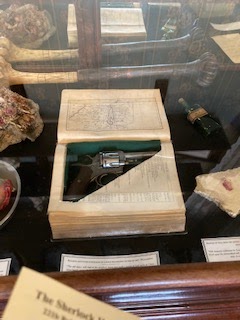Our first week my students and I hit what I would consider to be two must-see stops while in London: the British Museum, which is colossal and requires at least a day to view (we were a little rushed, so I will probably need to go back there) and the Sherlock Holmes Museum...much smaller but also very worth the visit. Obviously, my Detective Fiction students were required to hit that one.
I'll start with Sherlock, mainly because we got a lot of photos and were encouraged to take them. There was an audio guide leading patrons through the tiny little museum, and we were greeted by an old English bobby at the door and a Victorian-era dressed chamber maid led us through the displays. In addition to lovely displays of what could have been Sherlock's 19th century home on 221b Baker Street, there were wax figures representing characters in Sir Arthur Conan Doyle's stories, including this very creepy victim from "The Adventure of the Speckled Band."Sherlock's study was full of authentic Victorian artifacts: furniture, glass vials, and numerous other antiques very beautifully kept and preserved. While the museum is obviously a commemoration of the Holmes character, it is also creates a great comprehensive picture of Victorian English home living.
This guy is the Hound of the Baskervilles of course.
We see Sherlock's gun... but what don't we see! I looked everywhere for the box where the character would have kept his opium and coke...not to be seen. It's interesting what a museum does and doesn't reveal!
Note for teachers: A museum exhibit is also a text, and like the mysteries and detective stories we read, students can analyze what is revealed and what isn't, as well as what stories the details tell us.
You have to really examine these photos closely to see the level of detail...pretty awesome.
And here is where Sherlock shot up the wall with his gun one day. The pipe collection is right below.
As for the British museum...not sure we were really supposed to take photos. (I took a bunch.) What struck me most of all was not only the amount of artifacts taken from their home nations, but the incredible scale of what is kept there. This is from the Egyptian exhibit, and the photo might not allow for an appreciation of how huge these statues are. At a museum in the States, such as the Field Museum of Natural History in Chicago, you might see a mummy or two...but when you think the British Museum, don't think a dusty old corpse. Think a whole city ...that's the size of what you could see there. Full walls...entire tombs bigger than your living room. Something to think about.
You have to really examine these photos closely to see the level of detail...pretty awesome.
And here is where Sherlock shot up the wall with his gun one day. The pipe collection is right below.
As for the British museum...not sure we were really supposed to take photos. (I took a bunch.) What struck me most of all was not only the amount of artifacts taken from their home nations, but the incredible scale of what is kept there. This is from the Egyptian exhibit, and the photo might not allow for an appreciation of how huge these statues are. At a museum in the States, such as the Field Museum of Natural History in Chicago, you might see a mummy or two...but when you think the British Museum, don't think a dusty old corpse. Think a whole city ...that's the size of what you could see there. Full walls...entire tombs bigger than your living room. Something to think about.
Note for teachers: Encounters students should choose a region or historical era and use what they see in the museum to analyze the aesthetic and artistic values represented. Obviously, there are plenty of questions you might pose as a teacher of post-colonial studies, literature and otherwise.








No comments:
Post a Comment